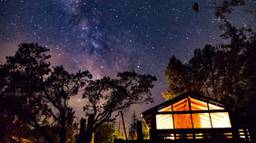• Average orbital speed: 2,287 miles per hour. Note that this number is very close to the moon’s diameter, making it the only known celestial body that moves through space at its own width per hour. This motion is readily visible from the Earth, even to the naked eye.
• Synodic period, or lunar month: 29 days, 12 hours, 44 minutes, 2.8 seconds. This is the average period from one full moon to the next.
• Rotation period: 27 days, 7 hours, 43 minutes, 11.5 seconds. This spin-time of the moon around its own axis is identical to the time it takes the moon to revolve around Earth, which is why the Moon always keeps almost the same face toward us.
• Surface temperatures: daytime, 235 degrees Fahrenheit typically; nighttime, can drop to -275 degrees Fahrenheit. This day/night range of 500 degrees is more than five times greater than that found in desert areas of Earth, but is typical of an airless world.
• Surface gravity: 5.3 feet per second. On the moon, an object would fall about 11 feet in two seconds. On Earth, an object would fall 64 feet in two seconds.
• Somewhere over the moonbow: A moonbow is a rare nighttime event. The moon must be clearly visible in one part of the sky while rain falls in the opposite part. Like a rainbow, a moonbow is an enormous arc in the sky – but it is much less intense than a solar rainbow. It usually appears spooky white, although all of the spectral colors are present. (The colors will show up photographically on high-speed film sufficiently exposed.)
• Why it looks so big: Who hasn’t turned down a road to confront a low, horizon-hugging moon that seems enormous? This is the famous “moon illusion.” Many people assume that this effect is caused by our atmosphere magnifying the image, but the explanation is far simpler. When the moon is high overhead, it is dwarfed by the vast hemisphere of the heavens. By contrast, when the moon is low, it is viewed in proximity to earthly objects, such as chimneys or trees, whose size and shape provide scale.











